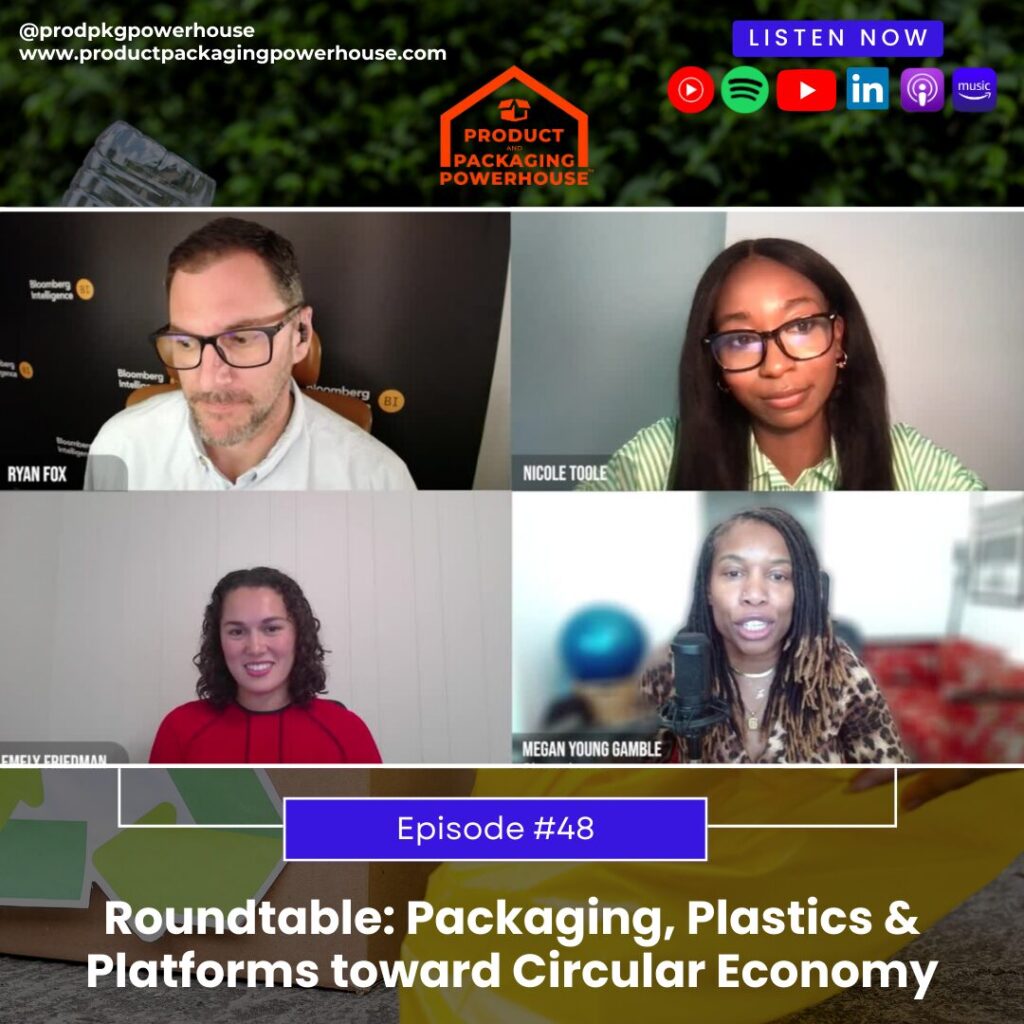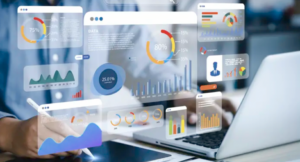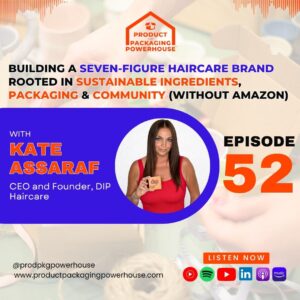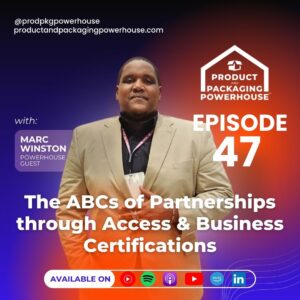What You’ll Learn from This Blog:
- What sustainability means across packaging, plastics, and recycling industries.
- How technology and consumer incentives are shaping the circular economy.
- The role of policy, business realities, and EPR laws in driving change.
Introduction:
The drive towards a circular economy is a hot topic, and understanding the realities of packaging, sustainability, and business tactics is crucial. In a recent special episode of the “Product and Packaging Powerhouse, host Megan Young Gamble sat down with industry experts Emily Anne Friedman (Recycled Plastics Editor, ICIS), and Ryan Fox (Packaging Analyst, Bloomberg Intelligence) and Nicole Toole (Founder of ECGO) to unpack definitions of sustainability, the impact of data and technology, consumer education, and policy approaches like EPR. The panel considers how to move toward a more circular economy, while acknowledging the real-world constraints of infrastructure, cost, and market incentives.
Here’s a look at the key takeaways from their insightful roundtable discussion.
Q1: What does “sustainability” mean in the context of the corrugated packaging industry?
A1: Ryan, who covers the corrugated packaging market, highlighted the industry’s strong focus on circularity. He explained that corrugated packaging boasts an impressive ability to capture and repurpose old corrugated containers, turning them into new versions with a high recycling rate, largely sourced from commercial and industrial sectors.
Q2: How do you define sustainability within the plastics industry?
A2: Emily, a senior editor covering recycled plastics markets, emphasized that while recycling is important, true sustainability starts with reduce and reuse. She stressed the need to look beyond just recycled content (PCR) and consider the broader carbon footprint of sourcing and transporting materials. For Emily, sustainability involves a holistic view of resource impact.
Q3: What is the core principle behind Eco, Nicole Toole’s mobile application?
A3: Nicole, founder and CEO of ECGO, explained that her platform is built on human behavior and waste stewardship. ECGO rewards people for recycling, aiming to drive consistent consumer engagement by making recycling easy, providing incentives, and tailoring guidelines to local regulations. The core mission is to shift consumer attitudes towards better end-of-life processes for products.
Q4: How is technology being leveraged to improve plastic recycling and advance the circular economy?
A4: Emily pointed to the impact of digital sorting and AI-enabled quality controls. She noted that while the US has significant mechanical recycling capacity, it’s underutilized due to contamination and feedstock issues. Technologies like advanced sorting can help improve the quality of recycled plastics, making them more viable for end markets. She also mentioned chemical recycling as a potential solution for achieving virgin-like quality for specific applications.
Q5: What is the primary source of recycled materials in the corrugated packaging market, and where is the untapped potential?
A5: Ryan stated that in the corrugated space, at least 80-90% of recycled materials come from commercial and industrial sectors, not curbside collection. The untapped potential lies in the residential sector, where millions of tons of old corrugated containers (OCC) are still found in landfills. Encouraging residential participation is seen as key to improving an already robust system.
Q6: What are the biggest barriers to effective residential recycling, and how can they be overcome?
A6: Nicole identified a lack of trust in the recycling system and a general lack of awareness about the impact of waste as major hindrances. Consumers often don’t see the impact of landfills or the tangible results of recycling. Overcoming this involves educating people on the impact of their choices, building trust in the process, and making participation simple and incentivized, as her app Eco aims to do. Ryan Fox also emphasized the need for incentives and minimal costs for residential consumers to “buy in.”
Q7: How is Extended Producer Responsibility (EPR) for packaging impacting the plastics industry, and what are the challenges?
A7: Emily explained that EPR legislation, though passed in only seven states, presents a behemoth of compliance for brands due to varying rules on covered items, fees, and infrastructure. The goal is to shift the financial burden of collection to producers. She noted that some policies offer incentives for using recycled content, encouraging brands to adopt more sustainable packaging. However, the complexity of managing different state regulations is a significant challenge.
Q8: What role does economic viability play in achieving circularity?
A8: Ryan raised a critical point: circularity is challenging if it doesn’t make economic sense. He illustrated that the cost of collecting and processing recyclables from curbside can be significantly higher than the market value of the materials themselves. This economic disparity often favors commercial and industrial recycling streams, which are more efficient and profitable. Nicole Toole echoed this, questioning how residential recycling can fit into this economic model if the majority of recovered materials come from commercial sources.
Q9: What is one common misconception about plastics in the industry?
A9: Emily addressed the notion that “all plastics are bad.” She argued that plastics are essential for many modern-day needs, playing a crucial role in preserving products and even keeping us alive in various applications, from medical packaging to everyday items. The challenge, she suggested, is not plastics themselves, but how we manage their end-of-life. Ryan strongly agreed, highlighting the indispensable role of plastics in everything from phones to healthcare.
Q10: Looking ahead, where do you see your respective industries heading in the next 3-5 years in pursuit of a positive circular economy?
A10:
- Ryan Fox (Corrugated Packaging): More recycled mills and production capacity, supported by continued lightweighting and material innovations, as well as stronger commercial recycling streams.
- Nicole Toole (ECGO App): More consumer participation and engagement in recycling behavior, driven by better incentives, local guidelines, and targeted education campaigns.
- Emily Friedman (Recycled Plastics): A recovery and a return to anticipated levels as markets adjust post-disruption, with ongoing improvements in recycling technology and policy alignment that encourage higher-quality recycled plastics.
The conversation underscored that achieving a truly circular economy is a complex, multi-faceted challenge. It requires technological innovation, shifts in consumer behavior, robust infrastructure, supportive policy, and, crucially, economic viability. As host Megan concluded, it’s a marathon, not a sprint, and bringing all stakeholders to the table is key to driving positive change.
🎙️ Listen to the full podcast HERE
Want to ensure your brand is EPR-ready and communications are on-point? GLC can assess gaps and align your messaging with policy requirements. 📩 Schedule a Discovery Call here

Emily’s Bio: Emily Anne Friedman is the Recycled Plastics Senior Market Editor for Americas ICIS, where she delivers in-depth reporting, analysis, and market insights at the forefront of the global plastics circular economy. With a degree in Materials Science and Engineering from Virginia Tech and past experience at ExxonMobil and 3M, Emily brings technical depth and journalistic clarity to one of the world’s most dynamic sustainability sectors. Passionate about climate action, data-driven storytelling, and community impact, she also served in leadership roles within the Society of Women Engineers and is a vocal advocate for women in STEM.
LinkedIn: https://www.linkedin.com/in/emilyannefriedman/ Company Website: https://www.icis.com/explore/
Nicole’s Bio: Nicole Toole is the Founder & CEO of ECGO, a tech-driven platform accelerating the shift to circularity by engaging Gen Z and driving measurable impact on campus waste reduction. Since launching from her dorm room, Nicole has led ECGO to partner with major brands and universities across the U.S. She’s a recognized advocate for climate action, with hands-on experience in ESG strategy, stakeholder engagement, and innovation in the circular economy. Nicole holds a BBA in Computer Information Systems from Georgia State University and is passionate about building solutions at the intersection of sustainability, technology, and youth empowerment.
LinkedIn: https://www.linkedin.com/in/nicole-toole/ Company website: https://www.ecgo.co/
Ryan’s Bio: Ryan Fox is a Corrugated Packaging Market Analyst at Bloomberg Intelligence, where he tracks pricing, demand, and plant-level trends shaping the U.S. corrugated box industry. With over a decade of experience spanning sales, analytics, and packaging operations, Ryan has developed data-driven insights that serve as a vital resource for box plants and supply chain stakeholders across the country. His deep understanding of the packaging ecosystem combined with a passion for “all things boxes” makes him a trusted voice in the industry.
Linkedin: https://www.linkedin.com/in/ryandfox/ Company website: https://www.green-markets.com/BOX/Index.html






